Artificial intelligence is trending.
Over the last decade, it’s become widely accepted that AI is more than just a buzzword. Across industries and verticals, AI-powered technology has begun to shape the way that organizations do business. From newly-founded startups to established global enterprises, companies of all sizes are seeing the value in adopting this technology to improve operations and solve business challenges.
In the world of paid search, it’s no surprise that Google has been on the cutting edge of artificial intelligence technology from the very beginning. Since the introduction of automated bidding, the search engine giant has continued to foster innovation and provide advertisers with AI-powered pay-per-click (PPC) solutions.
For many search marketers, however, the idea of artificial intelligence and machine learning often comes with hesitation rather than excitement. As project workflows become increasingly more automated, marketers are forced to hand over the reins and release some control over their campaigns to artificially-powered algorithms. Moving past manual bidding can feel daunting even for the most experienced PPC practitioner.
At Directive, we recognized that the tried-and-true manual approach to paid search was no longer bringing in sufficient marketing results. As a result, we came up with a new strategy that combines broad match keywords with Google’s machine learning technology to optimize the bidding process for higher conversions with less ad spend. We call it Smart Broad.
In this guide, we will discuss the Smart Broad methodology, walk you through how to structure a Smart Broad campaign, and share key findings from our results that you can apply to your own paid search tactics.
Background
At the beginning of 2020, the Directive team noticed an interesting trend across our portfolio of accounts. When observing PPC campaign results over the last three years, the overall cost-per-click (CPC) rate was rising. After digging deeper into the data, we found that CPC rates increased by 152% during this time.
Whether it was increased competition or other external market factors that caused this, we’re still not sure. All we knew is that something about our strategy had to change to account for these fluctuations. After all, the numbers don’t lie.
These findings lead us to rethink our entire traditional PPC campaign strategy. Shortly after, Smart Broad was born.
Fast forward to a couple months later, this campaign structure drove CPA rates down by 45%.
Here’s how we did it.
The Traditional PPC Strategy
At Directive, we traditionally take a manual approach to PPC campaigns. This allows us to have full control over the entire campaign creation process from beginning to end as well as optimize the bids and keywords as we see fit. Our traditional approach uses single keyword ad groups (SKAGs) with either broad modified, exact, or phrase match keywords.
The main challenge of a manual strategy is the level of time and effort that’s required to manage it. Especially for large accounts with many ongoing campaigns, it can be incredibly time-consuming to maintain optimal results.
What is the Smart Broad Approach?
Simply put, Smart Broad is a multi-layered paid search strategy that combines broad match keywords with Google’s automated smart bidding offering to drive lower cost-per-action and higher conversions. This approach merges the heightened level of control observed in a manual campaign with the time-saving benefits of automated bidding.
Broad Keyword Overview
Keyword match types are used to set parameters for the types of queries your ads can appear for. Google currently offers four keyword match types: broad, broad modified, phrase, and exact.
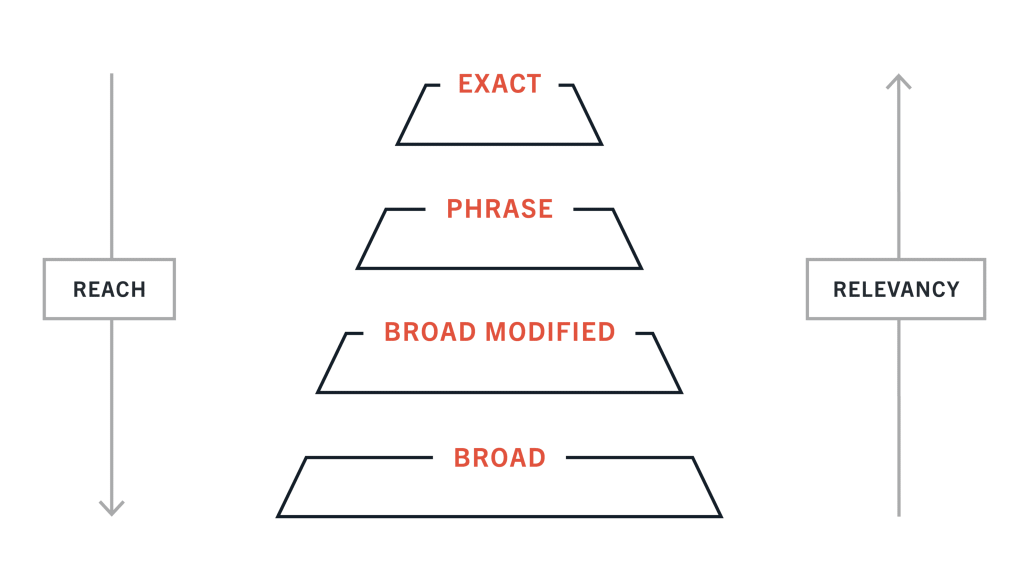
When you select the broad keyword match type, Google will show your ads for different variations of your chosen keyword(s). This includes synonyms and singular/plural forms of the term. For example, let’s say your business sells human resources software and you want your ads to show up when users search for the phrase “HR software.”
Using broad match, your ads will also show up for different variations of this target phrase such as:

As you can see, some of these results are spot on, others are not. Broad match enables your ads to get maximum exposure, but it also means that the ads can show up in search queries that are not relevant to your business. For this reason, broad match is rarely used by PPC professionals for manual campaigns. However, when paired with an automated bidding strategy, broad match can actually be very effective. More on this later.
How Smart Bidding Works
Google introduced smart bidding in 2016 as a subset of its existing automated bidding strategies. Smart bidding is unique in that it’s specifically designed to maximize conversions. Through machine learning algorithms, each strategy is set up to target the right bid to every auction — a featured referred to as “auction-time bidding.” Google uses a variety of contextual signals such as time of day, device, location, and others to make highly specific bidding decisions in real-time.
This takes a lot of the heavy lifting off your shoulders, giving your team more time to focus on other areas of your marketing strategy instead of manually managing the entirety of the bidding process.
There are currently six smart bidding strategies to choose from:
- Enhanced cost-per-click (CPC)
- Target impression share
- Target cost-per-action (CPA)
- Target return on ad spend (ROAS)
- Maximize conversions
- Maximize conversion value
Each smart bidding strategy is designed to target a specific end goal. When developing the Smart Broad approach, we recognized target CPA as the most effective smart bidding strategy. Throughout this article, we will look closer at target CPA and share how it helps to generate positive results.
Methodology
Having the right amount of data is critical to seeing results through smart bidding. This has less to do with how big your business or budget is, and more to do with how well your existing ad campaigns have been performing.
Google advises that an account has a minimum of 30 conversions in the last 30 days in order to be successful.
In addition to the level of data, it was important to look for accounts that would be compatible with the AI component of smart bidding. For example, businesses that operate in a very niche market would not be a good fit for a Smart Broad campaign. These types of campaigns already require a very high level of complexity when it comes to targeting keywords since there’s usually very low search volume to work with. Google’s machine learning algorithm is not yet advanced enough to effectively target these queries.
With this in mind, we carefully selected a list of 17 accounts (2 business-to-consumer, 15 business- to-business) that would be a good fit to enroll in our Smart Broad experiment.
Hypothesis
To test the efficacy of our idea, we came up with one simple objective: drive cost-per-action (CPA) down while maintaining a favorable level of intent in the search queries.
We hypothesized that using broad match keywords would keep the CPC rate down, while the smart bidding component would allow for maximum conversions within reasonable budget constraints.
Test Results
When put into action, the Smart Broad approach outperformed our traditional strategy across the board. In our sample size of 17 client accounts, this campaign succeeded in driving CPA rates down by 45%.
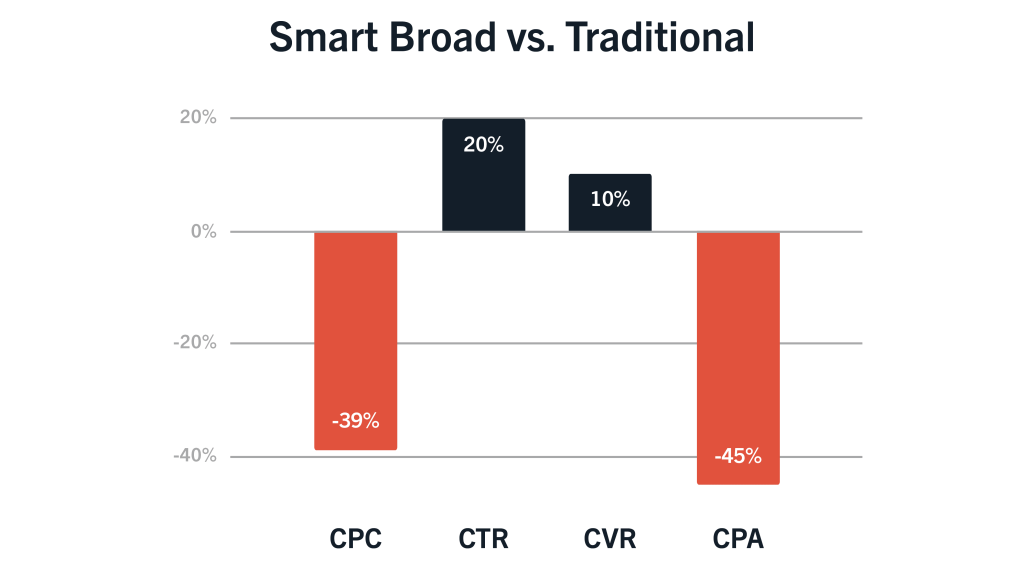
Here’s a quick breakdown of the additional performance metrics:
- CPC: 39% lower
- CVR: 10% higher
- CTR: 20% higher
Note: These figures are averages that represent all the accounts in the sample size.
When evaluating lead quality from the Smart Broad campaign, our data showed that the lead to MQL rates remained consistent with the rates we typically see with our traditional campaigns.
Benefits of Smart Broad
Following the initial test run, it became clear to us that this strategy has massive potential to change the way we approach PPC campaigns in the future.
We’ve identified three overarching benefits:
- Future-Proof Your PPC Strategy
Whether we like it or not, search marketing is moving in the direction of AI-powered bidding. The distinct benefit of Smart Broad is that it allows marketers to find a balance between level of control and automation. When you combine the ability to control queries with the time-saving benefits of smart bidding, you’re able to operate at a much higher level of efficiency. Businesses that are able to harness the power of this technology now are in a much better position to be ahead of the curve.
- Ease of Implementation
Overall, implementing and scaling the Smart Broad strategy is fairly straightforward. While it still requires some level of ongoing maintenance, you are doing much less of it. Your team can spend more time focusing on innovations and strategy, and less time adjusting bids.
- Measurable Results
Smart Broad works, plain and simple. Across the board, the Smart Broad campaign delivered significant results that exceeded our expectations. We successfully were able to drive down CPA rates for our clients, while maintaining high-quality search queries.
Additionally, we noticed that these results were easily replicated across different sized accounts and industries. This means that companies with budgets of any size can implement this strategy and customize it to fit their needs. Businesses with smaller budgets will likely require a longer initial learning period. This refers to the time required for the smart bidding algorithm to process enough data for optimal bidding. That being said, we’ve determined that a longer learning period will not hinder long-term success.
If you’re interested in learning how to build your own Smart Broad campaign, we’re going to cover that next.
Building a Smart Broad Campaign
Like any well-oiled machine, there are necessary levers that need to exist in order to get the gears turning and working properly.
Smart Broad is structured in a way where each layer of the campaign acts as a filter. This allows you to customize the campaign and pull certain levers to make adjustments as needed. Additionally, these layers help to filter out unqualified traffic and unprofitable clicks.
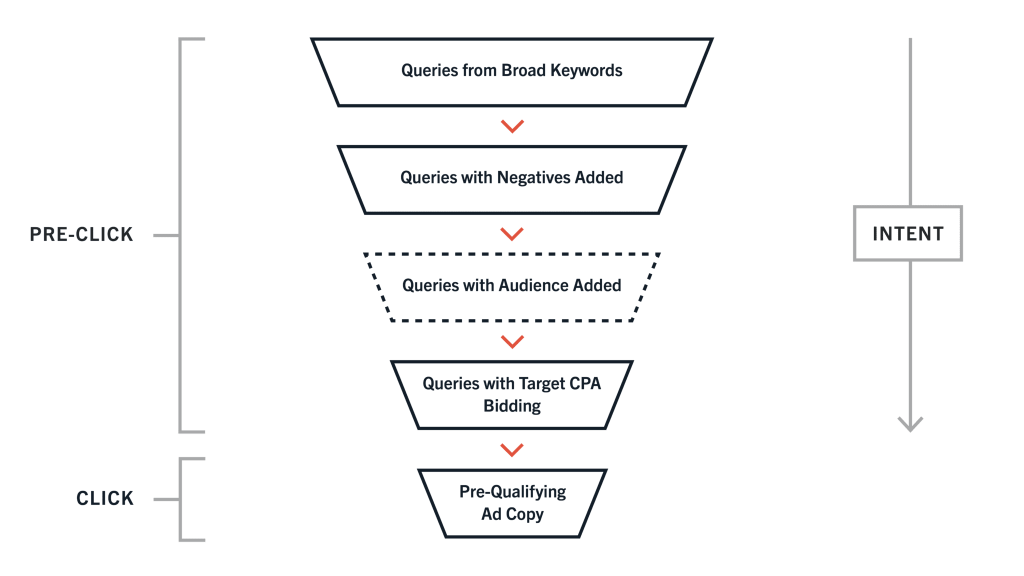
We discuss each layer of the campaign in terms of “pre-click and click.” This refers to the time before the user actually sees your ad. Anything pre-click refers to the internal elements of the campaign that must be in place before the users will see it. On the flip side, anything during the “click” phase refers to the point in time when the user sees the ad.
Let’s break down each key component individually.
Single Intent Ad Groups
When it comes to account structure and segmentation, we recommend using single intent ad groups to keep targeting as tight as possible.
When you have an ad group that satisfies a single search intent, you have the ability to write ad messaging that aligns directly with the user’s needs and position an offer that the user finds uniquely valuable. Single intent ad groups are leveraged to increase alignment with searches and improve conversion rates.
Broad Match Keywords
Keywords are the foundational elements of all paid search campaigns. Out of the four possible match types supported by Google Ads, broad match made the most sense for this strategy.
Here’s why.
As the default setting in Google Ads, broad match works by showing your ad when a user searches for different variations of the target keyword or even related topics. This can run the risk of your ad appearing in irrelevant search results. In general, irrelevant clicks lead to lower conversions and ultimately, wasted ad spend.
However, the reason this match type works well when paired with smart bidding is because the algorithm works with the entire text of the query, not just the keyword. This means that the machine will work to find additional queries and synonymous terms that are relevant to your objective. Additionally, using broad match enables you to get a low cost-per-click while tapping into queries that the other match types do not allow for.
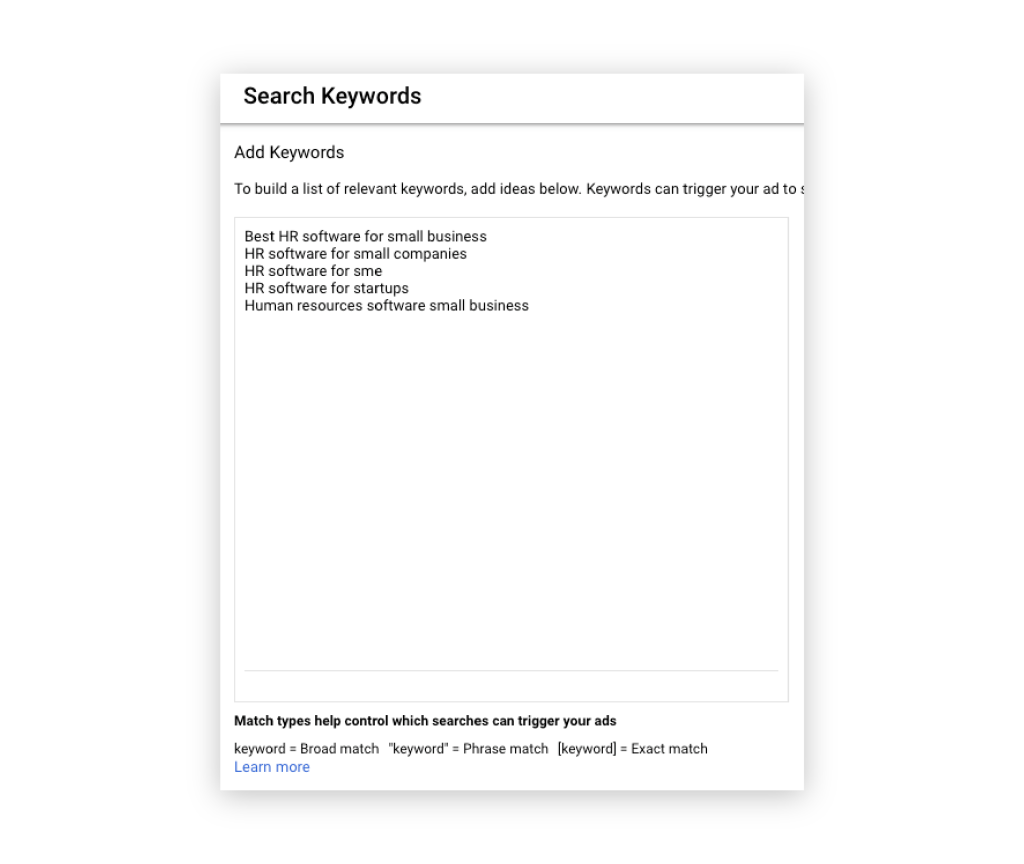
What Keywords Should I Use?
When selecting keywords to target in our Smart Broad campaign, we recommend starting small with four to five bottom-of-funnel (BOFU) keywords that relate specifically to your business’s core offering. In this case, a bottom-of-funnel keyword is a search phrase that explicitly shows purchasing intent.
Let’s use the HR software example from earlier. For the sake of simplicity, we’ll say that this software company only sells to small businesses.
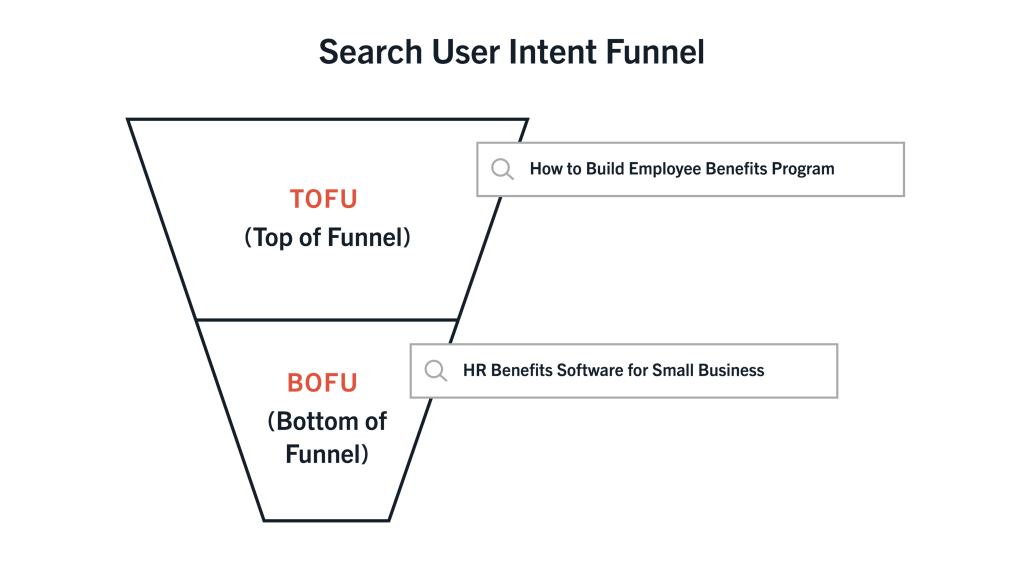
A prospective buyer might use these BOFU keywords when searching for an HR software solution:
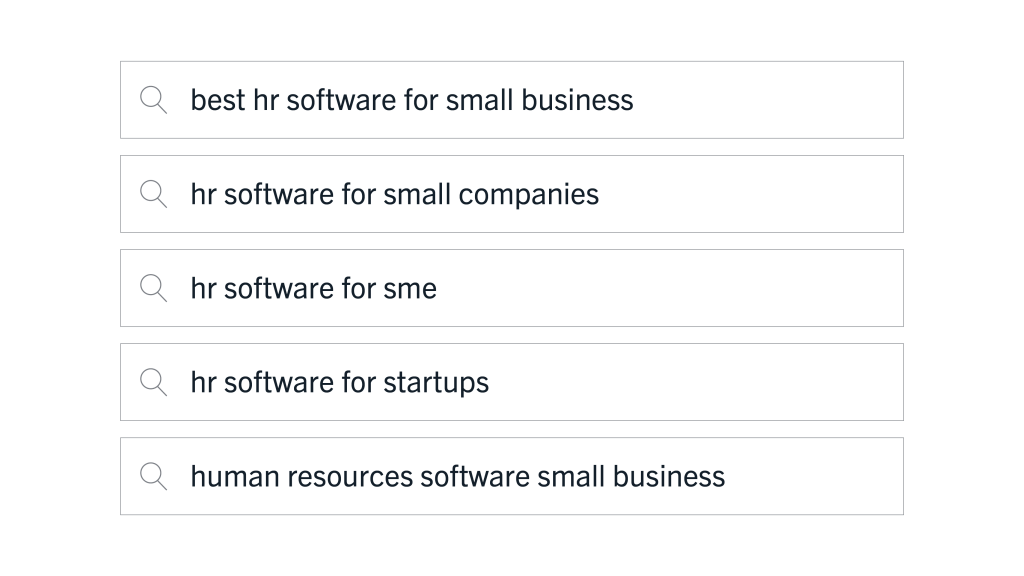
Someone who is using these keywords as part of their search is clearly showing that they are actively in the market for this type of solution.
If you’re struggling to find the right keywords, you can also revisit search terms that have performed well in past campaigns. This way, you’re targeting keywords that have the potential to perform well again.
Negative Keywords
The first layer of filtering in the Smart Broad strategy is implementing negative keywords. Doing this allows you to exclude specific keywords from your campaign. This ensures that your ads don’t show up for irrelevant search queries that don’t pertain to your business.
At Directive, we frequently use negative keywords in our paid search campaigns. To find negatives for Smart Broad, we simply pulled a list of keywords that we had previously identified for existing ad campaigns. However, if your team is new to negative keywords, there are a variety of SEO tools available on the market such as Ahrefs and Google Keyword Planner that can help do this.
For example, “free HR software” is not a keyword you want your ads to appear for. Other negative keyword examples might include “free hr software for nonprofits” or “hr block tax software.”
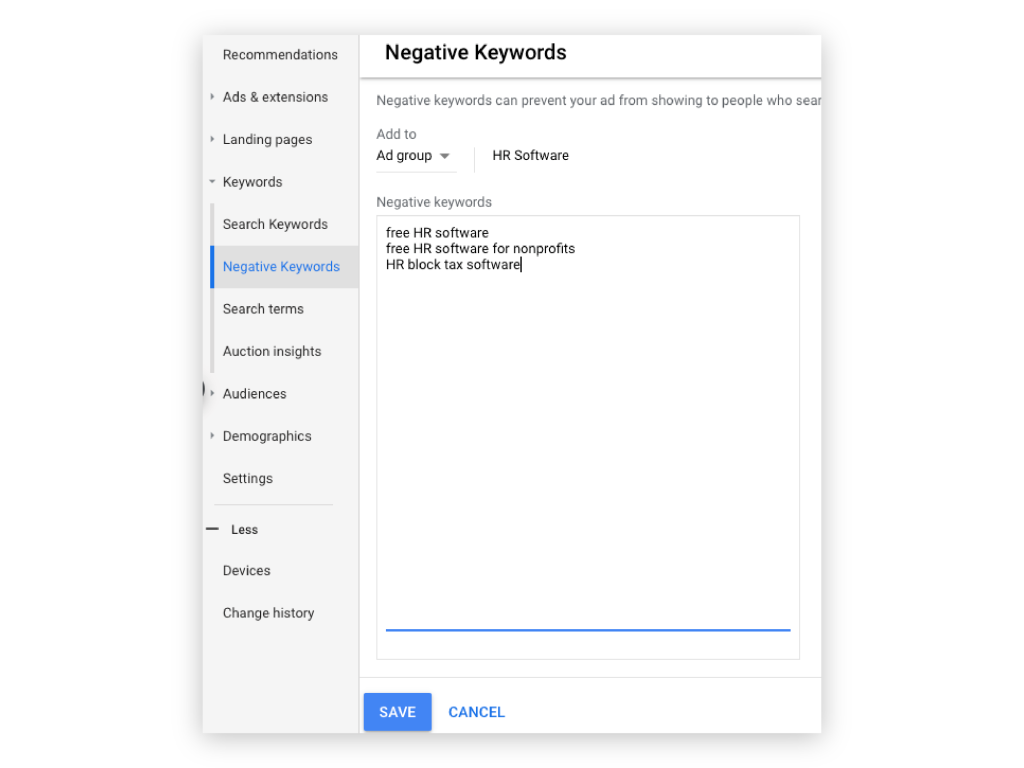
Once your campaign is up and running, you can also utilize Google’s search terms report to build out your negative keywords list. This report shows you exactly which search terms triggered your ad to appear, making it easy to identify irrelevant keywords.
Audiences
The next component of the Smart Broad campaign structure is adding an audience filter. This AI-powered feature allows advertisers to narrowly define their audience and target these users based on demographics or browsing behavior. Google has a variety of audience targeting options. For optimal results, in-market or custom intent audiences should always be used for a Smart Broad campaign.
It’s important to note that this step is entirely optional. The reason we built it into the campaign structure is so it can act as an additional safety net. Just pull the lever as needed.
Determining whether or not you need to implement this step is simple: a week after launching your campaign, take a look at the search terms that your ads are showing up for. If these terms are still not quite relevant enough to your target audience, you have the option to add audiences to narrow in on more qualified queries.
Audience Settings
Google Ads offers two different audience settings: targeting and observation.
The targeting setting allows you to show your ads to a specific audience. This will significantly limit who will be able to see your ads. The observation setting will still show your ads to everyone, but it allows you to observe how your ads perform against certain audience criteria while your campaign is running.
When adding the audience filter to a Smart Broad campaign, we recommend using the observation setting to begin with. If time passes and you notice that your ad is still showing up in irrelevant search queries, then it’s a good idea to test out the targeting setting.
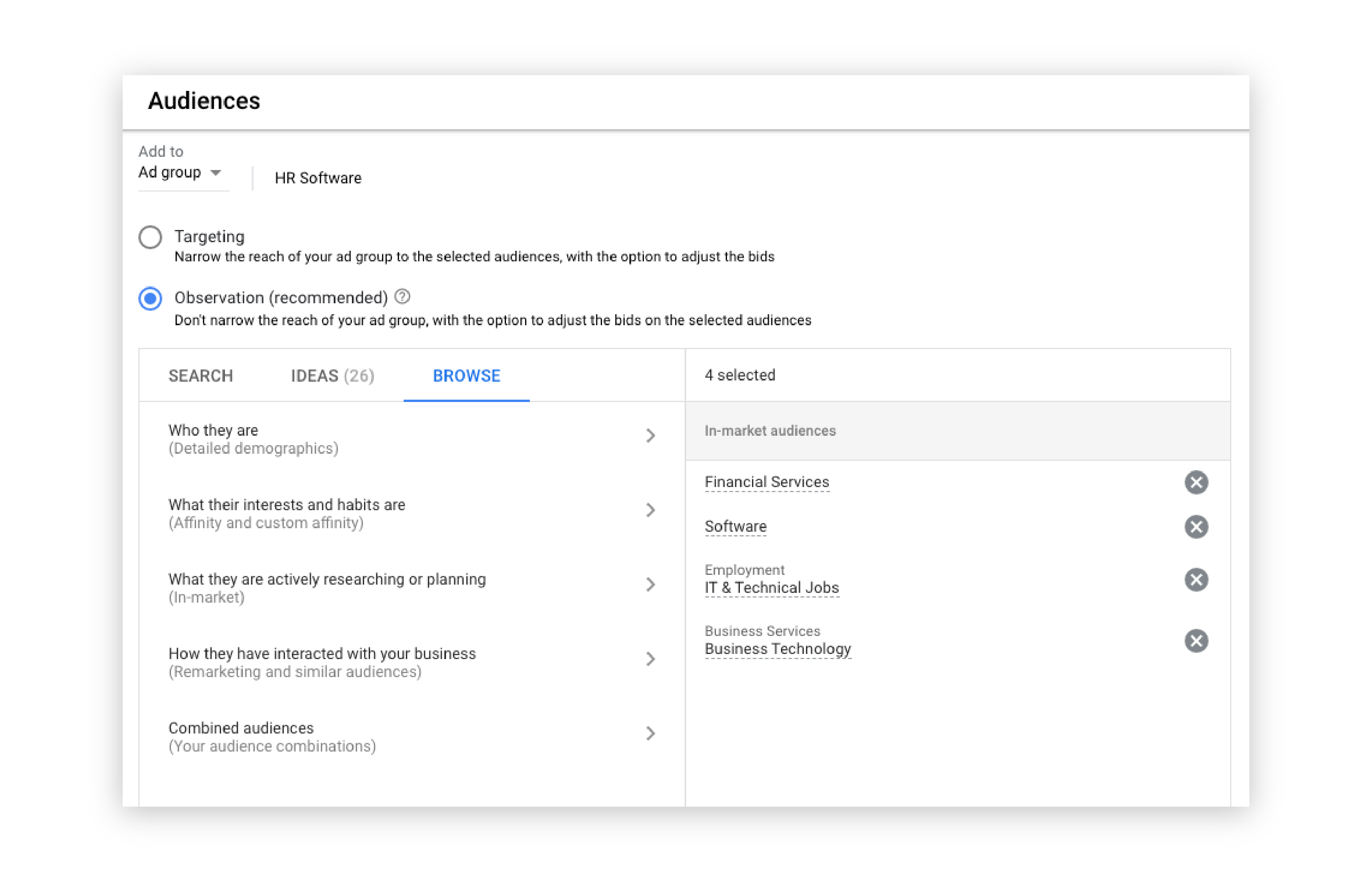
Smart Bidding Strategy
This is the last filter in the pre-click phase of the campaign. As mentioned previously, Google Ads currently offers six smart bidding strategies and each is aimed at reaching a different objective. When developing the Smart Broad approach, our team identified target CPA as the most effective strategy to pair with broad match keywords as it helps to weed out any queries that are not likely to convert.
By design, the target CPA strategy is set up to optimize for conversions at or below the designated cost-per-action. Using Google’s auction-time bidding feature, the algorithm relies on previous campaign data and contextual signals to find the optimal bid for your ad.
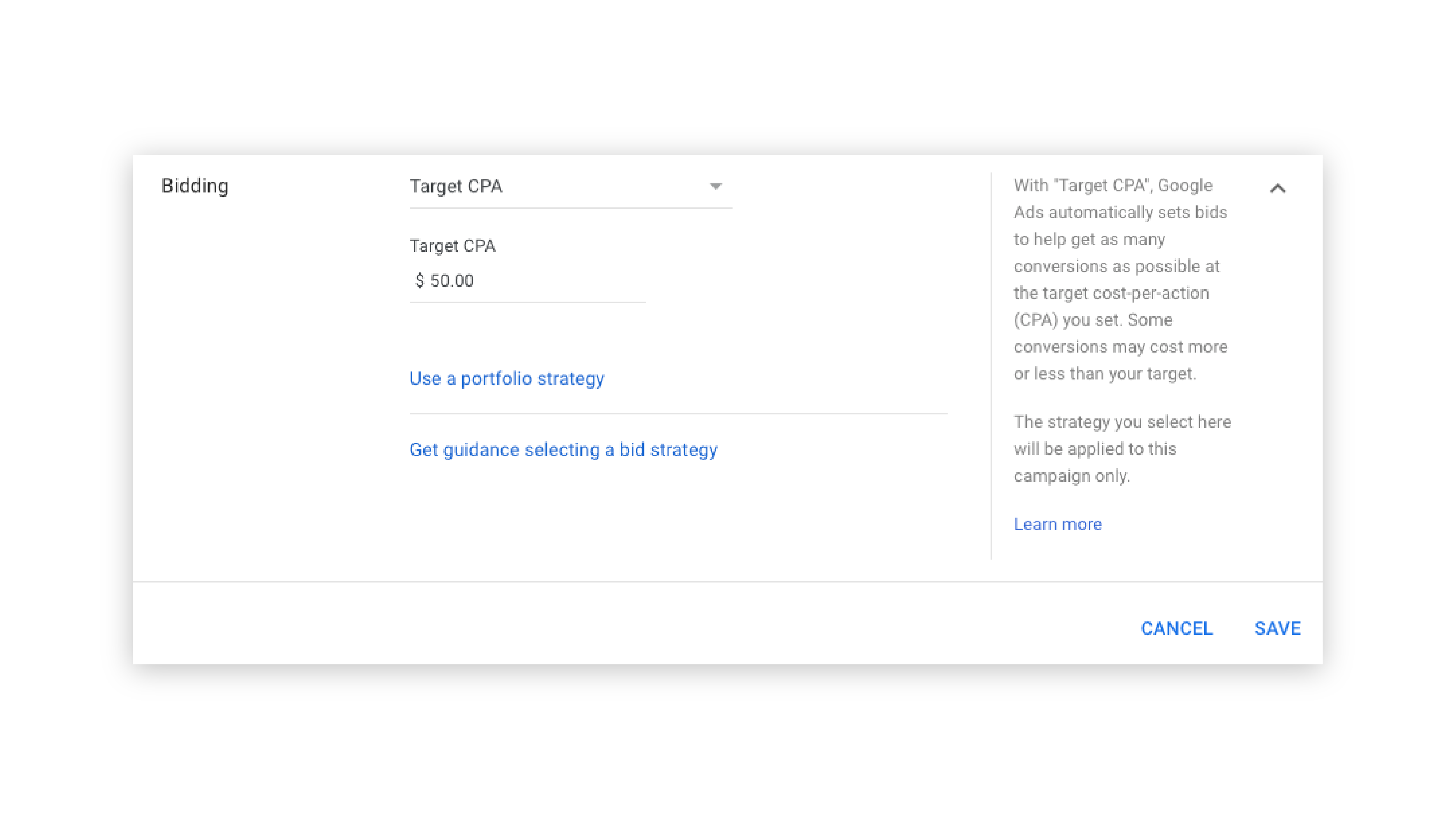
When it comes to setting the actual target CPA, we suggest using the number that Google automatically recommends. This figure is determined using performance data from your past campaigns. If the recommended CPA is far over your planned budget, it’s a good idea to review your financial targets and determine the maximum amount you can afford to bid.
Pre-Qualifying Ad Copy
With all the foundational filters in place, the final layer to the Smart Broad approach is creating highly-targeted ad copy that further filters out low-intent traffic. Up until now, we’ve done everything we could to get the queries as high-intent as possible. This step will help to take this even further to ensure that the people who click on the ad are the ones that we’re targeting in the first place.
Here are a few best practices to follow when writing copy for search ads:
- Urgent—Use language that entices the reader to take action sooner rather than later.
- Useful—What specific problem is your audience looking to solve? How will your offering help them to solve it?
- Unique—What makes your business stand out against competitors?
- Ultra-specific—How is the offer personalized to fit your audience’s needs?
If your HR software company sells only to small businesses, don’t hesitate to add “small business” in the ad copy. If a prospective buyer from an enterprise company comes across your ad, you want them to read “for small business” and avoid clicking on it. The more specific you are in your messaging, the less money you waste on unqualified clicks.
It’s important to note that this filter has the potential to drive click-through rates down. We saw this happen across several accounts. In this case, a lower CTR was expected and simply means that the pre-qualifying ad copy is doing its job.
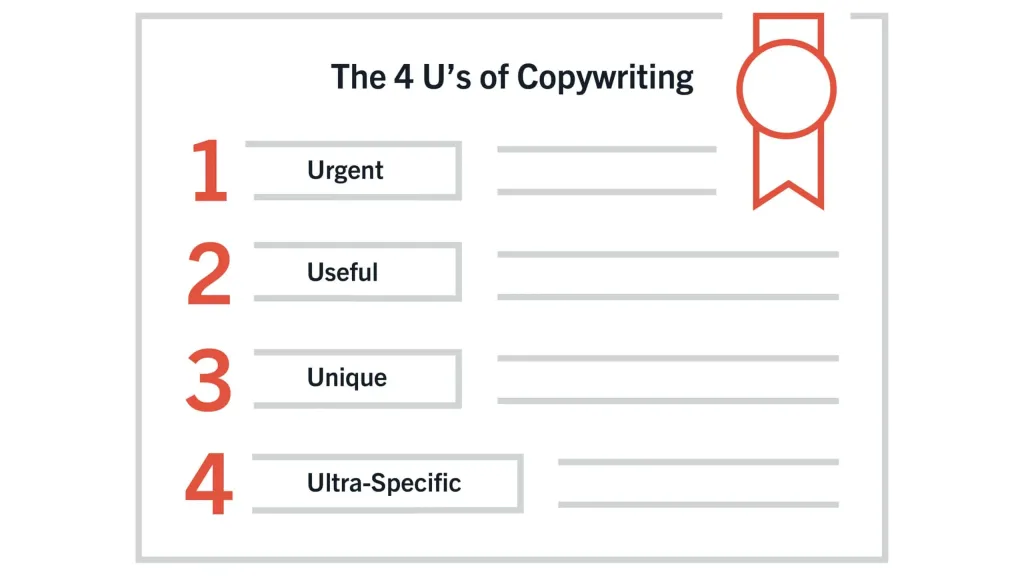
Primary Metrics
To track and measure Smart Broad campaign performance, we look at these primary metrics:
- Cost-per-action (CPA)
- Cost-per-click (CPC)
- Conversion rate (CVR)
- Click-through rate (CTR)
Although our primary objective revolves around CPA rate, it’s still important to look at these other key metrics in order to paint a full and accurate picture of how the campaign is actually doing.
Managing a Smart Broad Campaign
The day-to-day management of a Smart Broad campaign is fairly hands off and overall not much different from a traditional campaign. The most noteworthy difference is a heightened focus on the quality of search queries which your ads are showing up for. You should be consistently mining through search terms for additional negative keywords to add to your list.
At the same time, it’s important to note that seeing too many irrelevant search queries is a sign that it’s time to pivot and experiment with the different filters. Smart Broad was intentionally built with testable components that allow you to make adjustments as necessary.
Scaling Tactics
Once we established a basic campaign structure and began to notice positive results, we aimed to identify additional tactics that could take the Smart Broad approach to the next level.
There are a variety of elements you can test and alter to influence even better results. We recommend experimenting with the following:
Smart Bidding Strategy
Although target CPA is the recommended bidding strategy for a beginner-level Smart Broad campaign, our results showed that maximum conversions can also be implemented successfully for better-established accounts with higher conversion volume.
Creative Ad Copy
Ad copy isn’t meant to be static. It can always be improved and re-worked to better appeal to your audience and their needs. Experimenting with new messaging should be an ongoing process as it plays a big role in the long-term success of your campaign.
In-Market Audiences
As we discussed earlier, Google allows you to target specific in-market audiences based on a variety of criteria. Using the “observation” setting, you have the ability to experiment with this filter to better understand how it’s impacting your Smart Broad campaign without limiting the reach outright.
Alpha Tapering
The term “alpha tapering” refers to a tactic we use to isolate top-performing keywords and maximize impression share. The strategy is simple: identify your top-performing Smart Broad keywords and throw them into a separate campaign using only the exact match keyword type.
New Broad Match Keywords
Put simply, don’t hesitate to test out different keywords. If you’ve seen success with some of the original queries but not all, go back to the drawing board to identify different variations of the original search terms.
Additional Findings
Pre-qualifying ad copy is essential to fueling high-intent traffic.
Without pre-qualifying ad copy, we believe our overall click-through rate would’ve been much higher. The low CTR indicates that there were a lot of users that saw our ads, but didn’t identify with the offer that was being presented to them. They avoided clicking on these ads for a reason. We see this as a positive outcome because it’s likely that these users would not have converted if they did click through.
It’s critical to be transparent in your ad copy and align it with the actual offer that’s being presented on the landing page. This is a best practice for all of your paid search activities, not just for Smart Broad campaigns.
Experimenting with testable components can lead to better results.
As with any paid search strategy, there is no one-size-fits-all approach that can guarantee success for every business. In order to see ongoing results from your Smart Broad campaign, it may require pulling different levers and making some adjustments along the way. The testable components of the campaign (creative copy, bidding strategy, audience settings, etc.) allow for a high level of maneuverability.
Google’s machine learning technology has come a long way.
And it’s only going up from here. Opting into using these AI-powered tools enables businesses to future-proof their search campaigns. Machine learning algorithms are constantly learning and evolving to become smarter and more accurate. It’s clear that technology is on an upward trajectory, so don’t let a fear of the unknown cause you to fall behind.
Note: These findings are not conclusive. We studied a small sample size of accounts that is not representative of the population. Results are not guaranteed.
Conclusion
Overall, our findings indicate that when combined with the right foundational elements, an automated smart bidding strategy paired with broad match keywords has massive potential to bring in legitimate results. While some components of our campaign structure proved to be more critical than others, it’s the combination of all the filters and the automated bidding technology that make Smart Broad so effective.
At Directive, we recognize that it can be daunting to look past the trusty legacy strategy to experiment with new AI-driven tactics. Our experience with Smart Broad has taught us that search marketers should feel empowered to embrace innovation in our field, not shy away from it. Technology will continue to move forward whether we like it or not. It’s up to us to decide whether we want to adapt to the changes, or get left behind.
Other agencies might help you get discovered in search.